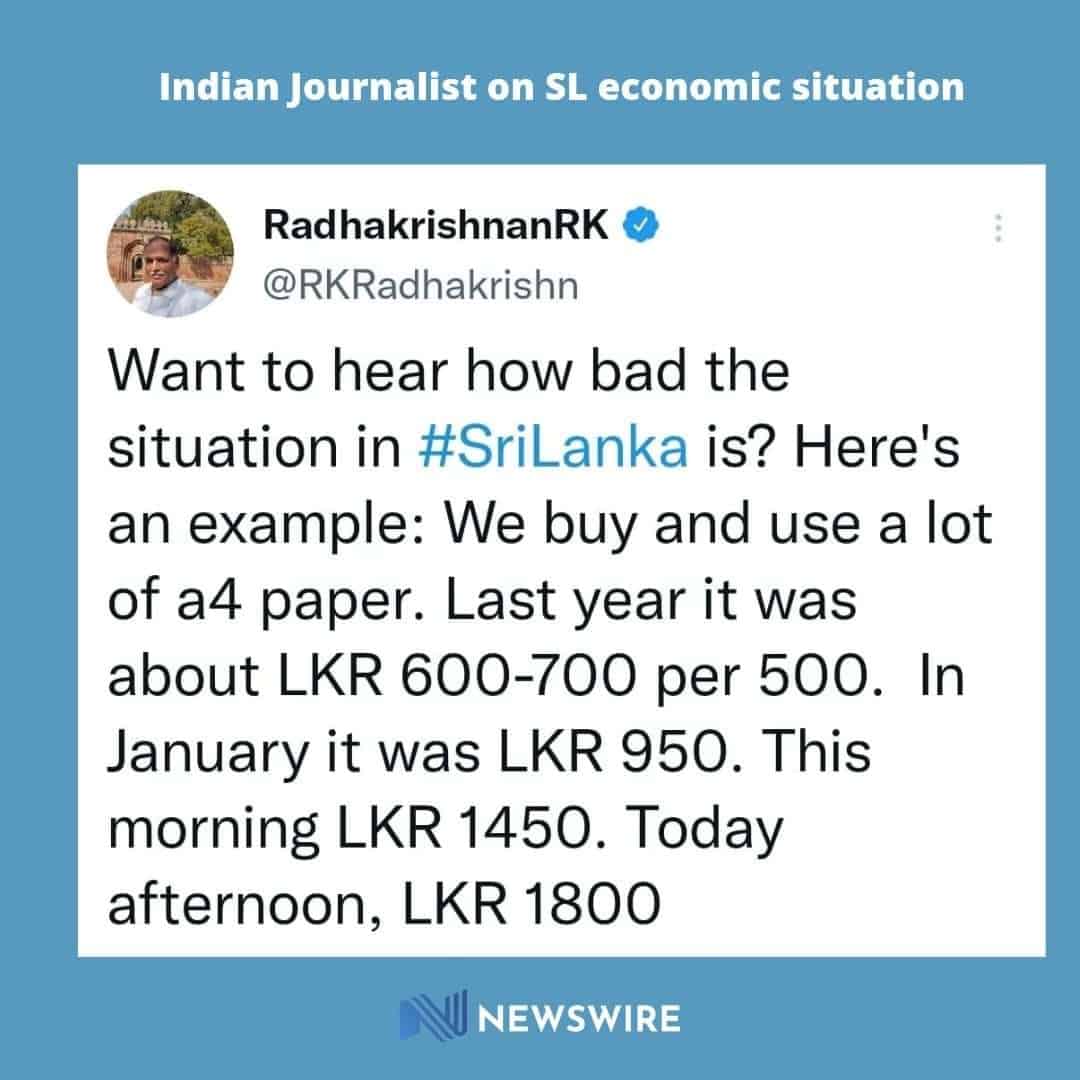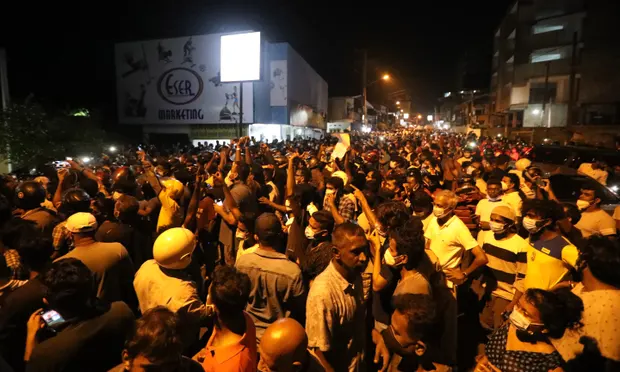What is going on in Sri Lanka?
What is going on in Sri Lanka? That is a question that cannot be answered without an in depth discussion of the world situation, including the invasion of Ukraine by Russia, and the debilitating economic condition of the world since the COVID 19 pandemic.
But in short, Sri Lanka is going through one of the worst phases of economic inflation in its history, since its independence in 1948, due to its foreign currency shortage.

Numbers
Sri Lanka’s fiscal reserves of foreign currency is close to $2.3 billion, against a maturing debt of more than $7 billion dollars in 2022, including a dollar bond worth $1 billion maturing in July.
In order to combat this quite exceptional debt, the Sri Lankan government in power has been trying various strategies. Currently Sri Lanka is being led by a coalition government, with Gotabaya Rajapaksa in power as the President, and his brother Basil Rajapaksa as the Finance Minister.
Initially, the government had declined to seek help from the IMF, and had set up strategies to increase the currency reserves through official lines of currency transference. In essence, non-resident citizens and people with overseas earning capacity were forced to exchange their currencies through specific government channels, which were offering a lower rate than the private exchange channels.
Reasons
The world economy has been wobbling for a while now. The resources of the planet are steadily depleting, which means the cost of acquiring them is rising in association. In addition to that, the pandemic brought about an absolute halt in the financial movements throughout the world. All of this has been concurrently affecting Sri Lanka’s economy for the last few years.
The current inflation, and the subsequent socio-political destabilization in the country can be attributed primarily to the Russia-Ukraine conflict.
A significant portion of Sri Lanka’s earning is sourced from tourism, which has been fervently affected by the pandemic. The foreign currency shortage has been aggravated by this, which has in turn caused a shortage of imported goods.
Among the necessary daily products that have seen a fall in supply is petroleum. Ukraine was one of the main exporters of petroleum to the island nation, and the war with Russia has stopped its business activities.
Politically, the opposition has blamed a series of tax cuts executed by the current government in 2019 as the one of the reasons for the current economic crisis. These cuts were made in response to the previous government’s tax hikes in keeping with the International Monetary Fund’s suggestions to fight inflation. That is a possible reason why the Rajapaksa government had initially been unwilling to seek help from the IMF.
Response
The Sri Lankan Central Bank had set up channels of repatriation for exporters to exchange their earnings from dollars to rupees, in order to boost their foreign currency reserves. In these channels the exchange rate had been pegged at a point lower than the rate offered by private channels. Utilizing the financial crisis, the government tried cracking down on these black market channels, which were gaining in popularity among traders.
Finally relenting on their stance on seeking a bailout from IMF, the Rajapaksa government had let the Sri Lankan currency fall in value. The step had confounded citizens and economists alike, since it would worsen the crisis. However, this response was due to the unpegging of the currency, which meant that the devaluation was a reaction of a re-embrace of the floating economic system.
In the international arena, Sri Lanka had undertaken a currency exchange with China worth around ten billion yuan, and has received another billion dollar stimulus from India. However, these steps have been insufficient in combating the crisis in any meaningful way.
Social Impact
Sri Lanka has been facing foreign currency shortage since the beginning of the pandemic. The situation came to head last year, as food, fuel, medicine, and paper fell in short supply. The government initially tried rationing food supplies by setting price caps and forcing farmers to sell their products to the government. The effort was soon reversed due to apparent uselessness, and the prices were allowed to rise exponentially in accordance with the discrepancy between supply and demand.
Moving into 2022, the picture of the island nation was literally dark and dismal. Due to the extreme fuel shortage, rolling power cuts had been introduced. There were winding, kilo-metre long lines outside of petrol stations, and the few vehicles that could afford to do so, drove on dark lamp-less roads. Children studied under the wavering light of candles and kerosene lamps, and production and work came to a standstill due to the lack of power.
Something as innocuous as paper was in such short supply, that within days the prices increased more than two fold, leading to such a shortage that institutions were unable to provide papers for writing exams.

Socio-political Fallout
With a shortage of items of daily sustenance, the social fabric of Sri Lanka had been unravelling for a while. Devoid of food, fuel, paper, and power, public anger was gaining significant traction. Considering that the Rajapaksa family is in control of most of the government, meant that the anger found a specific, and dare I say, accurate direction.
As the month of April fell upon the world, the immense statist machinery of Sri Lanka was left looking foolish, as protests erupted across the nation. In Colombo, a furious crowd tried to storm Rajapaksa’s home, with ironic chants of Lunatic Go Home.

Following this warranted protest, an expected government crackdown took place, with over 50 people arrested, armed forces deployed across the nation, and a curfew being imposed. An internet blackout was also issued immediately, to prevent people from expressing their anger and the news of the turbulent situation escaping into international attention. However, as has been learnt countless times by different parties in power, a centralised internet/social media ban is a largely ineffective and counterproductive way to combat information flow. The people of the country have defied curfews and found alternate avenues of information sharing, bypassing the government’s ill advised actions.

The furious protests have led to a mass resignation of ministers from the cabinet, including the sports minister Namal Rajapaksa, who is the nephew of the President. However the PM Mahinda Rajapaksa has retained his position, while his brother President Gotabaya Rajapaksa has invited the opposition to fill up the empty cabinet and help stave the economic crisis that has ballooned in the country.
What happens next, remains to be seen.
Inconclusive Opinions
With limited knowledge of the situation, and socio-economic history of the nation, it is difficult and somewhat unethical to betray opinions regarding it. However, having spent a while writing a fairly ineffectual case study of the crisis, I shall hazard a few personal sentences about it.
The economic crisis in Sri Lanka is symptomatic of a larger crisis in the world. The pandemic can certainly be blamed, but only for exacerbating an already tumultuous situation. The debt that Sri Lanka is supposed to pay off has been accumulated over decades, through the intervention of several governments in order to attain infrastructural development.
The idea of such development is itself inexplicable, considering the cost at which it is deemed to arrive. Indeed, what is the worth of roads, high rises, and power stations, when the raw materials to run them are out of reach?
The country is in a total of over $50 billion in debt, out of which $7 billion has to be paid by this year. In order to combat it the government has been seeking further credit inflows from allies in order to import more supplies.
The choice before the government was to service their outstanding debt payments or invest in buying food, fuel, and medicines. Take a moment to consider that sentence. Who is the government for? Who was the incurred debt meant to service, when the borrowing had been done?
On the face of it, this is indeed a financial crisis. A shortage of foreign currency. But digging deeper, we realise it is a shortage of resources, which need to be incurred with foreign currency. That immediately betrays the true face of global alliances, who are more willing to lend out money to the country, instead of opening resource donations. Because resources are more expensive than currency, which itself has a cost, beyond the fiat agency provided to it. However, to their credit, neighbouring countries have indeed opened channels for sending fuel and food to Sri Lanka.
And finally, as every crisis in history, it is a humanitarian crisis. A crisis of power, and who gets to wield it by making decisions about the essentials of life. Does a representative government really represent its people when a curfew is imposed and military deployed on the streets? When it is unable to provide the basic necessities required for sustenance? When the entire population, wants its resignation?
And will a change in power aid in addressing the situation? The Rajapaksa government had itself come to power citing the ineffectual policies of its predecessor.
The current opposition leader Sajith Premadasa echoes these feelings, asking for wholesale change, instead of the cosmetic musical chair of ministerial duties being swapped from one party to another.
At this juncture, as citizens of a globalized world, it falls upon all of us to ask the question, what is the wholesale change that has the possibility to address such a situation?
We are still awaiting an answer.







